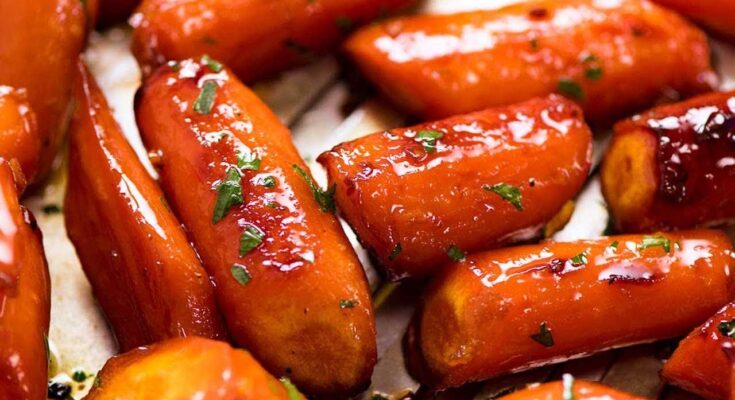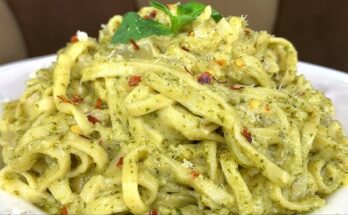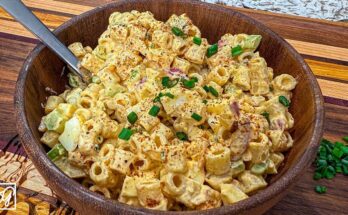Baked Carrots Recipe: You know those side dishes that quietly steal the show? Baked carrots fall right into that category. They’re humble, sweet, and slightly earthy—nothing too flashy at first glance. But once they hit the oven, magic happens. The natural sugars in carrots start to caramelize, giving them a golden-brown, slightly crisp edge with a buttery-soft center. It’s the kind of dish that turns even carrot skeptics into raving fans.
What makes baked carrots a kitchen hero is their versatility. They go with just about everything—roasts, grilled meats, vegetarian mains, or even tossed into grain bowls. Whether it’s a weeknight dinner or a holiday feast, these carrots know how to hold their own. Plus, they’re ridiculously easy to prepare. No deep frying. No complicated marinades. Just good, honest flavors enhanced by the right amount of seasoning and heat.
The simplicity of baked carrots is also what makes them so customizable. You can go sweet with honey and cinnamon, savory with garlic and thyme, or spicy with chili flakes and paprika. The possibilities are endless, and every variation brings something new to the table.
Nutritional Value of Carrots
Let’s not forget the health bonus. Carrots are packed with beta-carotene, which the body converts into vitamin A—great for your eyes, skin, and immune system. They’re also a solid source of fiber, vitamin K1, potassium, and antioxidants. When you bake them, you preserve a lot of these nutrients, unlike boiling where some vitamins may leach into the water.
Also, baked carrots have a low calorie count, making them perfect for those who are watching their weight without sacrificing flavor. So you’re not just making something delicious; you’re also nourishing your body in a seriously tasty way.
Ingredients You’ll Need
Freshness and Quality Tips
When it comes to ingredients, baked carrots don’t ask for much—but what they do ask for is quality. The fresher your carrots, the sweeter and more flavorful the final result. Look for firm, vibrant orange carrots with smooth skin. If they still have the green tops attached, that’s usually a good sign they’re fresh. Avoid any that are limp, cracked, or have a whitish film—that’s dehydration and poor storage talking.
For the oil, go with extra virgin olive oil for a rich, fruity touch. But you can also use avocado oil or even melted butter if you want a more indulgent flavor. And salt? Please don’t skimp. Use kosher or sea salt for better texture and flavor over plain table salt.
Here’s a basic ingredient list:
- 1 lb of fresh carrots (about 6-8 medium)
- 2 tablespoons olive oil
- 1 teaspoon salt
- ½ teaspoon black pepper
- 1 teaspoon dried thyme (or rosemary)
- Optional: 1 tablespoon honey or maple syrup for a sweet touch
Optional Add-ins for Flavor Twists
If you’re feeling creative, here are a few add-ins that can completely transform your baked carrots:
- Garlic cloves – Toss in whole cloves for a mellow roasted flavor
- Parmesan cheese – Add in the last 10 minutes for a crispy, cheesy top
- Cumin or curry powder – For a spiced, exotic twist
- Lemon zest and juice – Brightens up the flavor and balances sweetness
- Crushed red pepper flakes – Add heat if you’re into spicy food
These small touches can elevate your carrots from a humble side to a scene-stealing dish.
Preparing the Carrots
How to Choose the Right Carrots
Not all carrots are created equal. For baking, you want carrots that are medium-sized—thicker than a pencil but not as thick as your wrist. Baby carrots are okay, but they lack the complex flavor of whole carrots. Rainbow carrots are a fun alternative and add beautiful color to your plate, but keep in mind that some varieties (like purple ones) may have slightly different baking times.
Organic carrots tend to have a deeper flavor and fewer pesticides. If you’re going organic, that’s a win, especially since you might not peel them.
Peeling vs. Unpeeled – What’s Better?
Here’s the age-old question: to peel or not to peel? The truth is, you don’t have to peel carrots if you scrub them well. The skin is completely edible and contains valuable nutrients. However, peeling gives them a cleaner appearance and smoother texture. If you’re cooking for guests or want a more refined presentation, go ahead and peel. For rustic meals or when you’re short on time, just wash and go.
Slicing Techniques for Best Results
The way you cut your carrots can make or break this dish. Uniformity is key—uneven slices cook at different rates, leading to a mix of overdone and undercooked pieces.
Here are three popular slicing options:
- Diagonal Slices – These offer more surface area for caramelization and look elegant on the plate.
- Thick Rounds – Great for a rustic, hearty side dish.
- Carrot Sticks – Perfect if you’re serving alongside a main course like roast chicken or steak.
No matter how you slice them, aim for about ½-inch thickness to balance softness inside with crispy edges outside.
Seasoning the Carrots
Classic Seasoning Blend
Sometimes simple is best. A little olive oil, salt, and pepper is all you really need to bring out the natural sweetness of carrots. This minimalist approach lets the vegetable shine, making it perfect if you’re serving them alongside richly flavored main courses.
Start with tossing your sliced carrots in olive oil—just enough to coat them lightly, not drown them. Then, season with kosher salt and cracked black pepper. Mix until every piece is evenly coated.
Sweet and Savory Variations
Want to take your baked carrots to the next level? Try a sweet and savory combo. Here are a couple of crowd-pleasers:
- Honey-Glazed Carrots: Add 1 tablespoon of honey or maple syrup, a pinch of cinnamon, and a dash of nutmeg. It’s sweet without being cloying and pairs well with roasted meats.
- Garlic Herb Carrots: Add minced garlic and dried herbs like rosemary, thyme, or oregano. This brings an earthy depth that works beautifully with Italian or Mediterranean meals.
Using Herbs and Spices
Herbs and spices are your best friends when it comes to baked carrots. Fresh thyme and rosemary are particularly good choices—they hold up to high heat and infuse the carrots with subtle fragrance.
Feeling bold? Try these spice combos:
- Middle Eastern: Cumin, coriander, and paprika
- Asian-Inspired: Ginger, soy sauce, and a touch of sesame oil
- Mexican Flair: Chili powder, lime juice, and a sprinkle of cotija cheese
Each combo gives a whole new personality to the dish, so don’t be afraid to experiment!
Baking Process – Step-by-Step
Preheating the Oven: The Right Temperature
Set your oven to 400°F (200°C). This is the sweet spot for baking carrots—it’s hot enough to create crispy, caramelized edges without drying them out. Always preheat your oven first; putting carrots into a cold oven leads to uneven cooking and dull flavor.
How to Arrange the Carrots on the Tray
Line a baking sheet with parchment paper or aluminum foil for easy cleanup. Spread the carrots in a single layer—overcrowding causes steaming instead of roasting. If they’re touching, they won’t caramelize properly. Give them room to breathe!
For extra browning, use a dark-colored baking tray. It absorbs more heat and helps crisp the bottoms beautifully.
Baking Time and Texture Tips
Bake for 25-30 minutes, flipping the carrots halfway through. This ensures both sides get evenly caramelized. The final texture should be fork-tender on the inside with slightly crispy, browned edges.
Want them softer? Bake for 5-10 minutes longer. Want more crisp? Try broiling them for the last 2 minutes—but watch closely to prevent burning.
Serving Suggestions for Baked Carrots
Perfect Pairings for Every Meal
Baked carrots are the unsung heroes of side dishes because they go with practically everything. Want a quick veggie boost alongside a juicy grilled steak? Toss in some garlic herb carrots. Making a hearty winter stew or roast? Sweet and spiced carrots balance the richness perfectly. Even something as simple as baked chicken breasts or pan-seared tofu feels complete with a serving of golden-brown carrots on the side.
You can also serve them over a bed of quinoa or couscous with a dollop of hummus and some pickled onions for a Middle Eastern-inspired bowl. Or serve them cold the next day over a salad with feta cheese and balsamic glaze. They’re just that versatile.
Presentation Tips for Maximum Appeal
We eat with our eyes first, right? So why not make your carrots as gorgeous as they are tasty? A quick sprinkle of fresh chopped parsley or cilantro adds color and freshness. A drizzle of balsamic reduction or a dash of lemon zest can instantly elevate the look.
Serve them in a rustic ceramic bowl or a white platter to let their natural color shine. If you’re entertaining, garnish with microgreens or crumbled goat cheese for that gourmet touch.
Storing and Reheating Leftovers
How to Store Baked Carrots Properly
Leftovers? Lucky you. Baked carrots store beautifully and make for quick, nutritious additions to future meals. First, allow them to cool completely before packing them into an airtight container. If you’re using glass containers, even better—they help maintain the texture better than plastic.
Store them in the refrigerator, and they’ll stay good for up to 5 days. You can even freeze them, though they might lose a bit of their crispiness upon reheating. To freeze, lay them out in a single layer on a baking sheet and freeze until solid, then transfer to a freezer-safe bag or container.
Reheating Methods That Work Best
To reheat and retain the texture, the oven or air fryer is your best friend. Place the carrots on a baking sheet and warm at 375°F for about 10 minutes. If using an air fryer, 5–7 minutes at 350°F should do the trick. Microwave is fine in a pinch, but be prepared for a softer texture.
If you’re planning to add leftover carrots into a stir-fry, soup, or stew, there’s no need to reheat separately. Just toss them in during the final minutes of cooking.
Tips and Tricks for Perfect Baked Carrots
Common Mistakes to Avoid
It’s easy to think, “It’s just carrots,” but a few missteps can turn them from fabulous to flop. Here are some of the most common mistakes—and how to avoid them:
- Overcrowding the tray: This is probably the #1 mistake. If carrots are piled on top of each other, they steam instead of roast.
- Skipping the preheat: You need a hot oven to caramelize those edges.
- Too much oil: A little goes a long way. Drowning your carrots can make them greasy and mushy.
- Inconsistent sizing: Uniform slices are crucial for even baking.
Secrets for Enhancing Flavor
Want to take your carrots to the next level? Here are a few chef-level tricks:
- Roast with aromatics: Toss in a few crushed garlic cloves or onion wedges on the baking tray.
- Use a finishing touch: A drizzle of aged balsamic, maple syrup, or even tahini adds depth.
- Add acid: A splash of lemon or orange juice after baking brightens the entire dish.
- Go low and slow: For ultra-sweet and tender carrots, try roasting at 325°F for 40–45 minutes.
Variations and Twists on the Classic Recipe
Honey Glazed Baked Carrots
This one’s a fan favorite. Combine 1 tablespoon of honey, a pinch of cinnamon, and a dash of nutmeg. Toss your carrots with this mixture and bake as usual. The result? Sweet, caramelized carrots with a dessert-like appeal that pairs beautifully with savory entrees.
Spicy Roasted Carrots
For those who like a little heat, try adding ½ teaspoon of smoked paprika, a dash of cayenne pepper, and a pinch of cumin. Serve these with grilled meats, tacos, or even as a zesty addition to Buddha bowls.
Lemon Herb Roasted Carrots
For something light and refreshing, toss your carrots with olive oil, fresh lemon zest, and chopped dill or parsley. These pair wonderfully with seafood or spring-inspired menus.
Making Baked Carrots in an Air Fryer or Toaster Oven
Air Fryer Method
If you’re pressed for time or don’t want to heat up the entire kitchen, the air fryer is your best friend. Preheat to 375°F, place carrots in a single layer, and cook for 12–15 minutes, shaking halfway through. They come out just as crisp and caramelized, with a slightly different texture than oven-baked but just as delicious.
Toaster Oven Option
Don’t underestimate the power of a toaster oven. It’s perfect for small batches and works just like a regular oven. Use the same temperature and timing as you would in a standard oven, but keep an eye out—smaller spaces can mean quicker browning.
Kid-Friendly Baked Carrots
How to Make Them Appealing to Picky Eaters
If you’ve got little ones at home, you know the struggle of introducing veggies. Baked carrots, however, might just be your secret weapon. Their natural sweetness and tender texture make them a hit with kids—especially when seasoned just right.
Try cutting them into fun shapes using crinkle cutters or mini cookie cutters. Kids love anything that looks playful on their plate. Another trick? Add a touch of honey and cinnamon to bring out their candy-like flavor. Avoid strong spices like cumin or garlic if your kids are sensitive to bold tastes.
Fun Serving Ideas for Kids
Serve with a kid-friendly dipping sauce like ranch, hummus, or a mix of Greek yogurt and honey. You can even turn them into “carrot fries” by cutting them into thin sticks and serving in a paper cone. Another favorite? Mixing them with roasted sweet potatoes and a sprinkle of mini marshmallows for a sweet-and-savory treat.
Baked carrots are also a fantastic addition to lunchboxes. Just pack them in a small container, and they taste great even when cold!
Vegan and Gluten-Free Adaptations
Keeping It Plant-Based and Allergy-Safe
Good news—baked carrots are naturally vegan and gluten-free, so you don’t need to make many changes. Just make sure the seasoning you use is clean and doesn’t contain any hidden gluten (watch out for pre-mixed spice blends).
If you’re adding honey for sweetness and want to keep it vegan, swap it with maple syrup or agave nectar. Both give a similar rich sweetness and work beautifully with the carrot’s natural flavor.
For extra protein, you can toss in some roasted chickpeas or tofu chunks when serving. It’s a simple way to round out the meal while keeping everything plant-powered.
Baked Carrots for Special Occasions
Holiday Table Favorite
Baked carrots are a regular on holiday menus—and for good reason. Their bright color adds a pop of life to any table, and their flavor pairs beautifully with roasts, gravies, and stuffings. Add a drizzle of maple glaze or a sprinkle of toasted nuts for a festive touch.
Want to make them even more special? Serve them with a creamy herb sauce or a honey mustard dip. Dress them up with edible flowers or fresh herbs for a gourmet finish.
Serving at Gatherings and Potlucks
They travel well and reheat beautifully, which makes them a great choice for potlucks or family gatherings. Make them a day ahead, store in the fridge, and reheat just before serving. You’ll get all the flavor without the last-minute stress.
Try serving them in a cast-iron skillet or rustic baking dish—something that goes from oven to table and keeps them warm throughout the event.
Benefits of Roasting Over Other Methods
Why Baking Beats Boiling or Steaming
Boiling carrots can leach out nutrients and often leaves them bland and soggy. Steaming is a bit better, but it still doesn’t develop that rich, caramelized flavor that baking offers. Roasting in the oven brings out the natural sugars and creates those delicious crispy edges and deep flavors.
You’re not just softening the carrots; you’re transforming them. The texture becomes creamy on the inside, crisp on the outside, and packed with flavor. Roasting also gives you more control over seasoning and allows you to cook large batches without constant attention.
Plus, it’s healthier than frying and a lot less messy. No grease, no splatter—just beautiful, flavorful vegetables straight from the oven.
FAQs about Baked Carrots Recipe
1. Can I bake carrots without oil?
Yes! You can use a splash of vegetable broth, citrus juice, or even a light mist of water to keep them moist. They won’t caramelize as deeply, but they’ll still be tender and flavorful.
2. How do I keep baked carrots from getting mushy?
Don’t overcrowd the pan, and make sure your oven is fully preheated. Use high heat (around 400°F), and keep your carrot pieces uniform in size.
3. Can I bake frozen carrots?
Yes, but thaw them first and pat them dry. Frozen carrots can hold extra moisture that prevents caramelization.
4. What herbs go best with baked carrots?
Thyme, rosemary, dill, and parsley are excellent choices. For something different, try a sprinkle of za’atar or Italian seasoning.
5. Can I meal prep baked carrots?
Absolutely! They store well in the fridge for up to five days. Reheat in the oven or air fryer for the best texture.
Conclusion
So there you have it—a simple dish with extraordinary potential. Baked carrots aren’t just another vegetable side; they’re the kind of dish that can stand proudly on any table, whether it’s a weeknight dinner or a festive celebration. With endless seasoning options, easy prep, and crowd-pleasing flavor, they’re a must-try for cooks of all skill levels.
They’re affordable, healthy, easy to make, and universally loved. What’s not to like?
So the next time you’re wondering what to serve on the side—don’t overthink it. Just bake some carrots.



